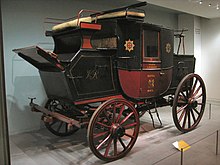Trunk
The trunk is the space in the car that is intended for the transport of cargo .
General
In vehicle types with a front engine , today the most common engine position in passenger cars, it is usually in the rear area . Vehicles with rear engine have except the trunk in the front area often another trunk before (eg. As VW Beetle ) or (z. B. VW 1600 ) the motor vehicles with central engine such. B. the Porsche 914 there is also another trunk behind the engine. Even the carriages of the late Middle Ages had one or two trunk spaces in front of or behind the passenger compartment. In the automotive sector, the installation of trunk compartments in connection with covered driver's cabs became widespread from the 1920s. At first they were only accessible from the inside, later generally from the outside. More recently, the trunk can often be opened conveniently by an electric motor at the touch of a button on the flap or with a radio remote control . Some manufacturers use sensor technology below the bumper to trigger the opening of the trunk lid with an indicated kick.

The volume of the trunk is usually given in liters , with a VDA procedure with standard cuboids (200 mm × 100 mm × 50 mm) being used to determine the volume . The procedure for loading the trunk with these measuring blocks is described in the DIN 70020-1 and ISO 3832 standards . The trunk is usually accessible from the outside via the tailgate or trunk lid.
A closed trunk is understood to be one that is not accessible from the passenger compartment or is only accessible via a through-loading / ski bag opening, while the open trunk is accessible by removing a cover or folding down the rear bench seat.
In a medium-sized car, the load volume is around 250–500 liters. In many car models, the loading volume can be expanded many times over by folding down the rear seat bench. This increases the loading length by around 50 cm. A station wagon usually has a loading length of up to two meters.
In addition to transporting luggage, the trunk can be used for numerous other purposes, for example to accommodate a spare wheel , an additional or gas tank in gas-powered vehicles, car hi-fi or an additional row of seats (e.g. in vans or station wagons) become.
If there is not enough trunk space, you can use a luggage rack . A trunk liner or trunk protector can be used to protect the trunk .
material
Trunks are mostly laid out with needle punch composite materials and, in high-quality combination models, sometimes also with tufted carpets.
In the case of luggage compartments that are not separated from the passenger compartment by sheet metal, the luggage compartment parts must also meet the VDA fire standards for interior parts (burning rate not more than 10 cm / min).
See also
literature
- Dieter K. Franke: VAG manual, Do it yourself, used car purchase-accessory installation-care. 1st edition, ADAC Verlag GmbH, Munich, 1984, ISBN 3-87003-227-8
- Hans-Hermann Braess, Ulrich Seiffert: Vieweg manual automotive technology. 2nd edition, Friedrich Vieweg & Sohn Verlagsgesellschaft mbH, Braunschweig / Wiesbaden, 2001, ISBN 3-528-13114-4
Individual evidence
- ^ Franz-Rudolf Esch: Strategy and technology of automobile marketing . Springer Gabler, Oestrich-Winkel 2013, ISBN 978-3-8349-3391-1 , p. 105 .


